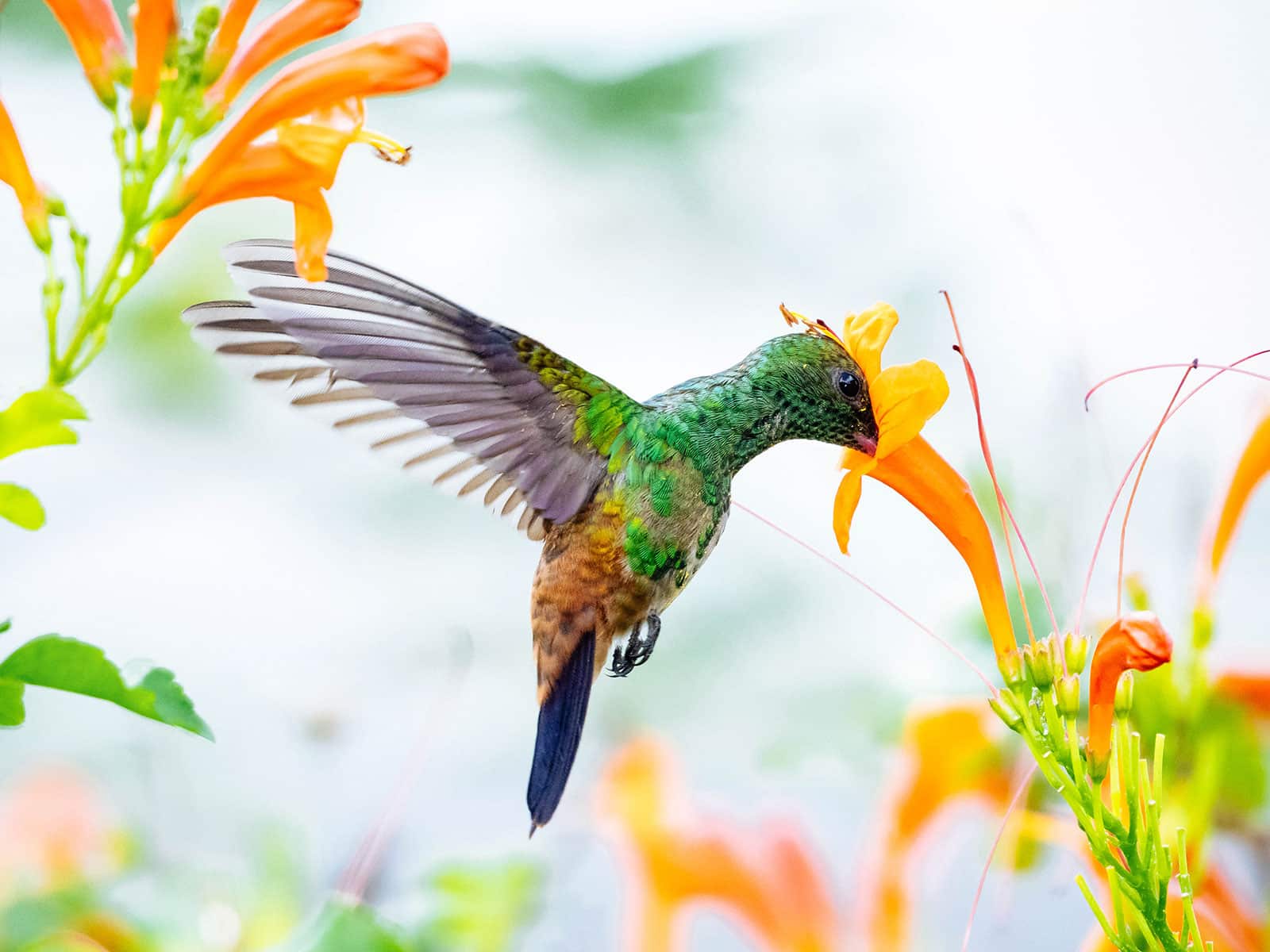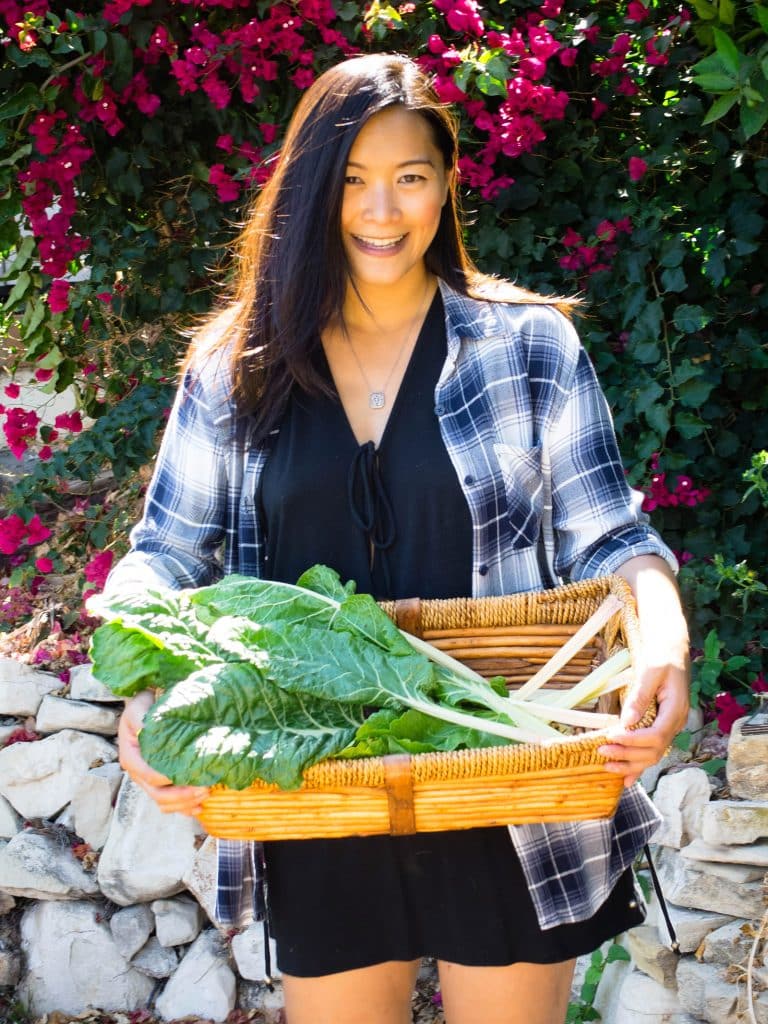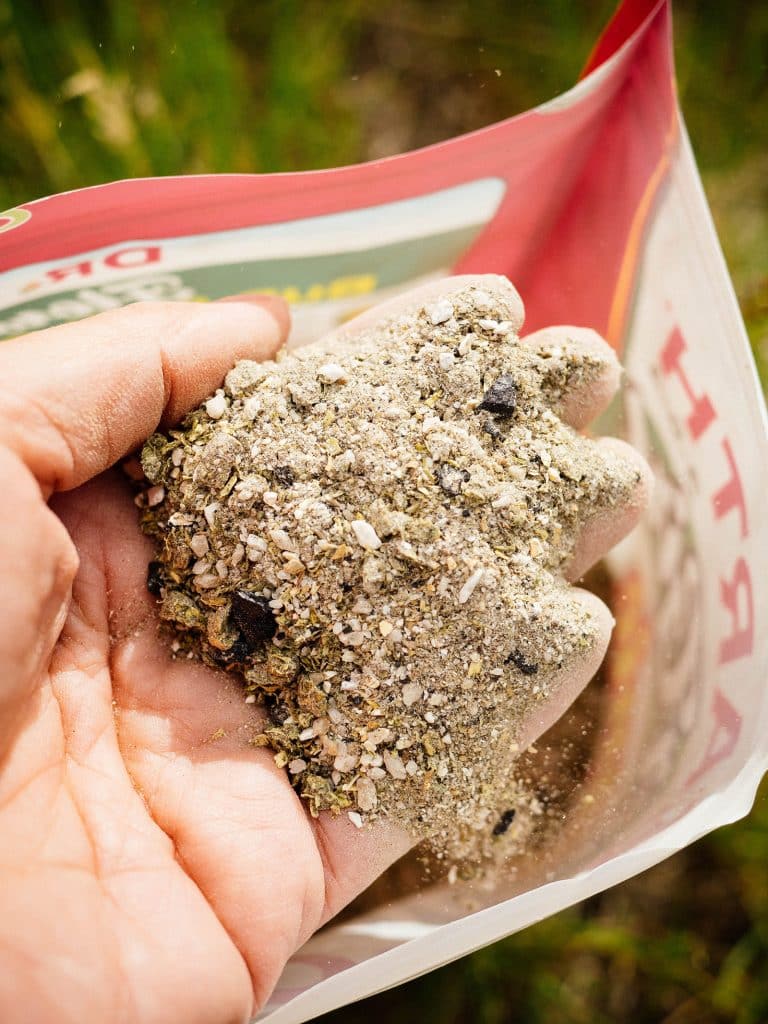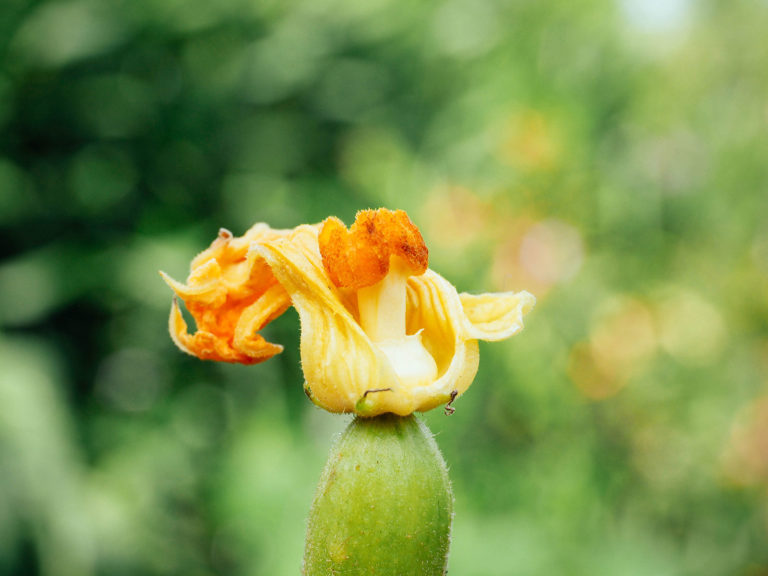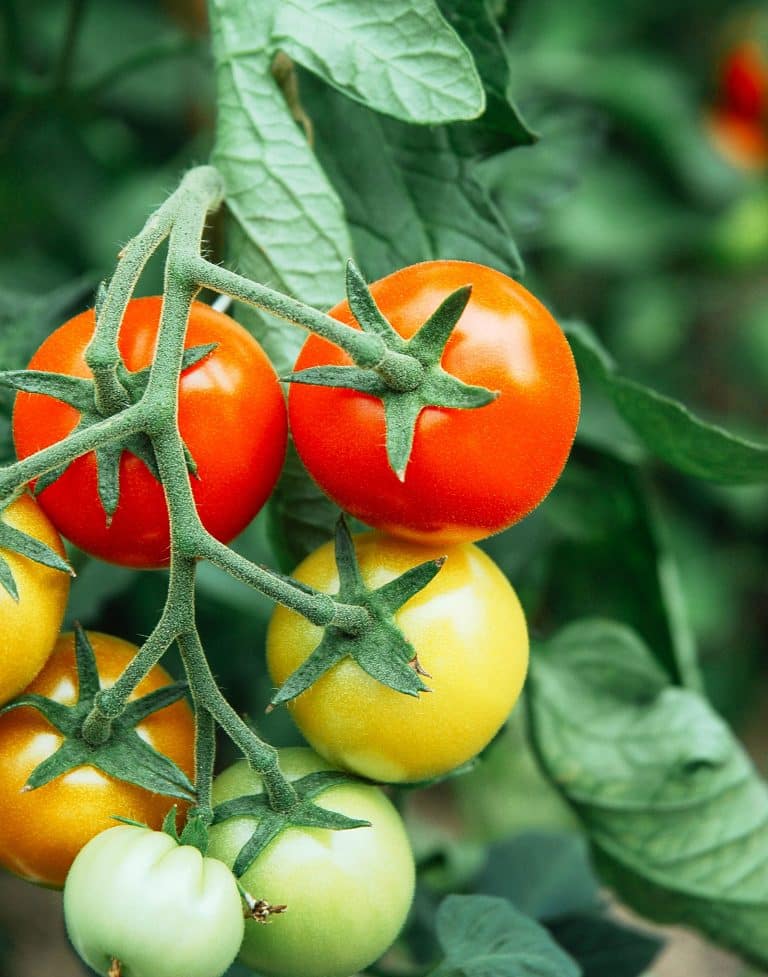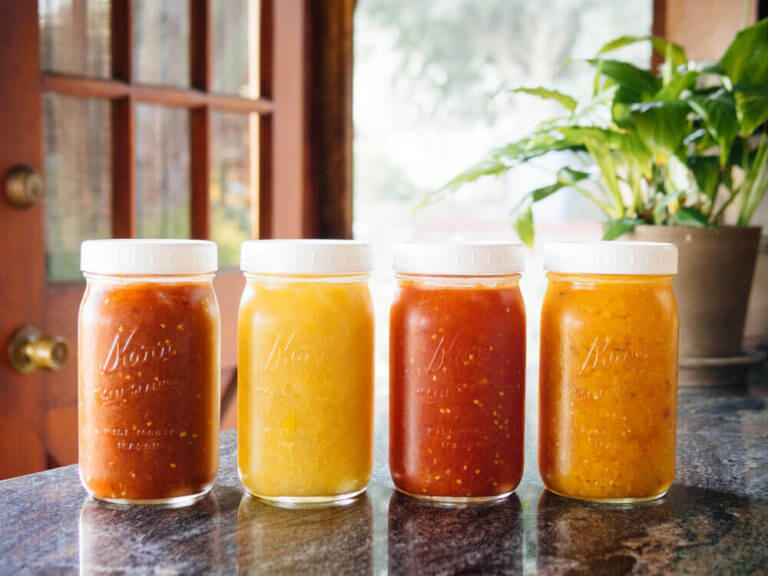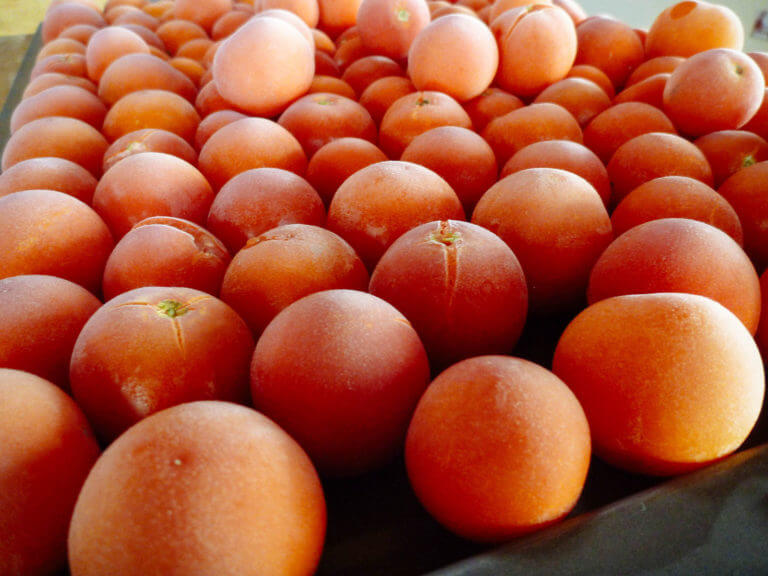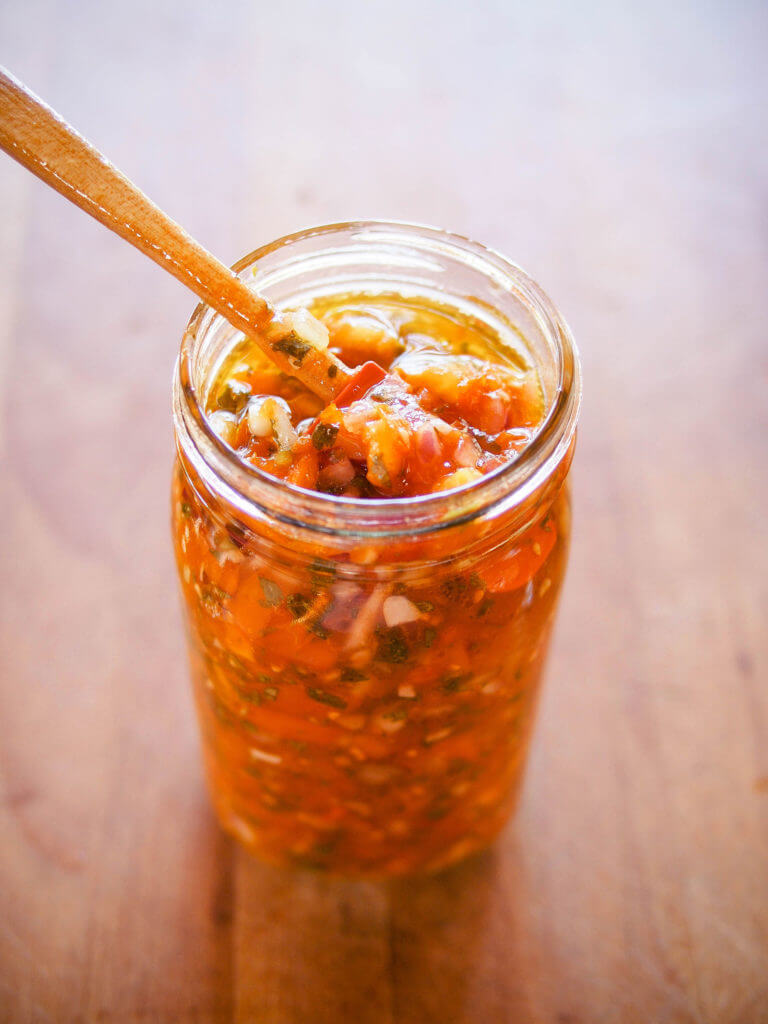Isn’t it such a joy seeing birds, bugs, and other small wildlife finding sanctuary in your garden? It means you’re doing something right: creating a mini ecosystem in your yard that’s teeming with life and beauty.
And while a garden can invite endless potential visitors, hummingbirds hold a special place. Their dazzling display of colors is a real head-turner, even though some species of hummingbirds barely weigh more than a nickel! They’re just so mesmerizing to watch as they flit from one flower to another, their wings a blur, and producing their signature “whirring” sound as they peruse and pollinate their favorite flowers.
If you love these tiny birds as much as I do, there’s an easy way to attract lots of them to your garden from spring to fall: plant the kinds of flowers they like.
Why you want hummingbirds in your garden
Hummingbirds aren’t just pretty to look at. As you probably already know, hummingbirds are pollinators. They visit flowers to feed on their nectar, inadvertently carrying pollen along as they do so. This means they can help ensure your fruit and veggie plants are fertilized and develop healthy, productive crops.
And though nectar is by far their favorite food, hummingbirds do regularly consume insects such as aphids, gnats, midges, ants, and even mosquitoes. They can snatch a spider right out of its web in flight!
All of that make hummingbirds a fantastic addition to your natural pest-control army, helping to keep your plants healthy and your evenings free of biting bugs.
Disclosure: If you shop from my article or make a purchase through one of my links, I may receive commissions on some of the products I recommend.
What flowers do hummingbirds like?
I can’t overstate how much hummingbirds love nectar! Sure, many other birds like it (sunbirds, lorikeet parrots, honeycreepers), but most hummers have evolved to barely eat anything else. The only other foods they regularly consume are insects (which contain a few important nutrients that nectar lacks) and tree sap (which they can drink if nectar is in short supply).
Some plants, like many of the popular air plants, have specifically evolved to only be pollinated by hummingbirds. Their flowers are shaped in such a way that other pollinators—like bees and butterflies—can’t properly reach their nectar, allowing only the hummers to drink it.
I’m sure you’ve figured out by now: If you want to attract hummingbirds, you’ve got to plant flowers that have plenty of nectar. What comes as a surprise to some people is that certain flowers produce little to no nectar (or nectar with relatively low sugar content), particularly those that have been bred for showy flowers or vigorous growth.
But while hummingbirds prefer flowers with abundant, concentrated nectar, they aren’t super picky about the types of flowers they visit. These jewel-like birds are generally attracted to any flower that ticks most of the following boxes:
- Opens during the day
- Tubular in shape
- Solitary or loosely clustered
- Is brightly colored
Interestingly, there are also some other aspects that we can’t see. For example, many traditionally hummingbird-pollinated flowers are scentless, meaning they’re not as attractive to insects. Their nectar is often extra high in energy-rich sucralose.
Also important is just the sheer quantity of flowers. Hummingbirds need to visit hundreds or more a day to sustain their super-fast metabolisms, so don’t hold back! If there’s not enough to go around, a few territorial specimens can keep others from visiting, or they may stay away altogether.
Do they prefer red flowers?
Hummingbirds seem to be most attracted to red flowers in the wild, but this behavior may be attributed more to feeding efficiency than a true preference.
Why? One explanation may be that bees don’t see red well. Blue, purple, and white flowers appear more clearly to them. Since bees tend to overlook red flowers, hummingbirds are more likely to find nectar in them.
This isn’t a hard and fast rule, however; they’re just as attracted to orange, purple, pink, yellow, blue, and white flowers.
Where to buy
Flower seeds and bulbs
If you don’t have much space for flowers, you could include a supplemental feeder with homemade hummingbird food to ensure there’s enough to go around.
Quick Tip
Be sure to include some nice perches near your flowerbeds. Research has shown that hummingbirds will actually choose inferior flower patches with perches over more nectar-rich patches without places to rest.
The best flowers to grow for hummingbirds
Alright, so we now know that hummingbirds like elongated flowers, especially those that are red in color. So what are some good choices if you want to attract them to your garden? Luckily, there’s plenty to choose from!
Be sure to combine different flowers. Although hummers are not known to be too picky, they are more likely to go for flowers that match their specific beak shape. So the more variety of flowers you plant, the more hummingbird species you’ll attract.
Here’s my tried-and-true list of the best flowers for hummingbirds!
1. Columbine (genus Aquilegia)

If there’s one genus of flowers we can’t miss on a list of flowers for hummingbirds, it’s Aquilegia, better known as the columbines. A significant number of the 60 or so species are native to North America. Because they bloom quite early in spring, they’re an important food source for our favorite flutterers and other pollinators.
Although columbines in general tick all the boxes for hummingbirds, the one species they’ll go crazy for every time is the eastern red columbine, scientifically known as Aquilegia canadensis. This beautiful wildflower is characterized by its delicate, bell-shaped flowers in shades of red and yellow, which grow on long stalks.
Columbines are sturdy and easy to grow. Their ideal growing conditions would consist of partial shade, well-draining soil with plenty of nutrients, and a medium moisture level. However, they’re not picky, and unless the soil is constantly wet they’ll thrive almost anywhere.
USDA Zones: 3 and up
2. Prickly pear cactus (genus Opuntia)
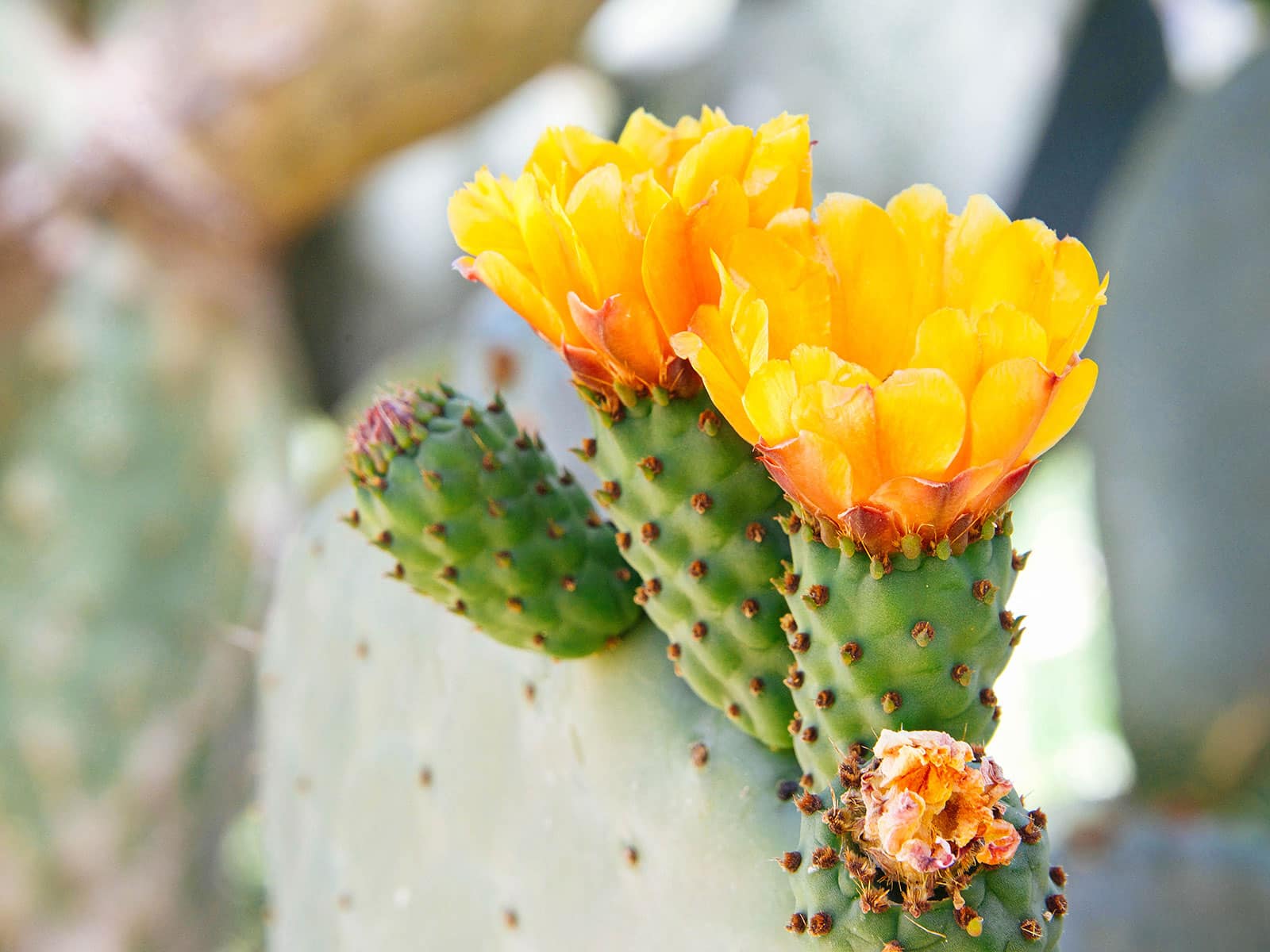
Many hummingbird species thrive in arid habitats. If you live in a state like Arizona or New Mexico, you may be able to attract rare species to your xerigarden! They’ve got a taste for various succulents.
Agaves (particularly A. parryi) are their favorites, but since these bloom only once and can take decades to do so, they may not be your best option.
A more feasible alternative for desert gardens would be the prickly pear cactus. Belonging to the genus Opuntia, prickly pears are easy to find at your local garden center and bloom abundantly on a yearly basis. They’re an excellent choice if you like both pretty flowers and hummingbirds.
You can choose any of the common species, but I think O. ficus-indica (the common prickly pear) is our winner. Not because hummingbirds like it more than other prickly pears, but because its fruits are edible and delicious, so it’s a win-win for both you and the birds.
Prickly pears are very easy to grow as long as you can offer well-draining soil and lots of sun. All you have to do is water when the soil is fully dry and maybe add some fertilizer every spring.
USDA Zones: 9 and up
3. Indian paintbrush (genus Castilleja)
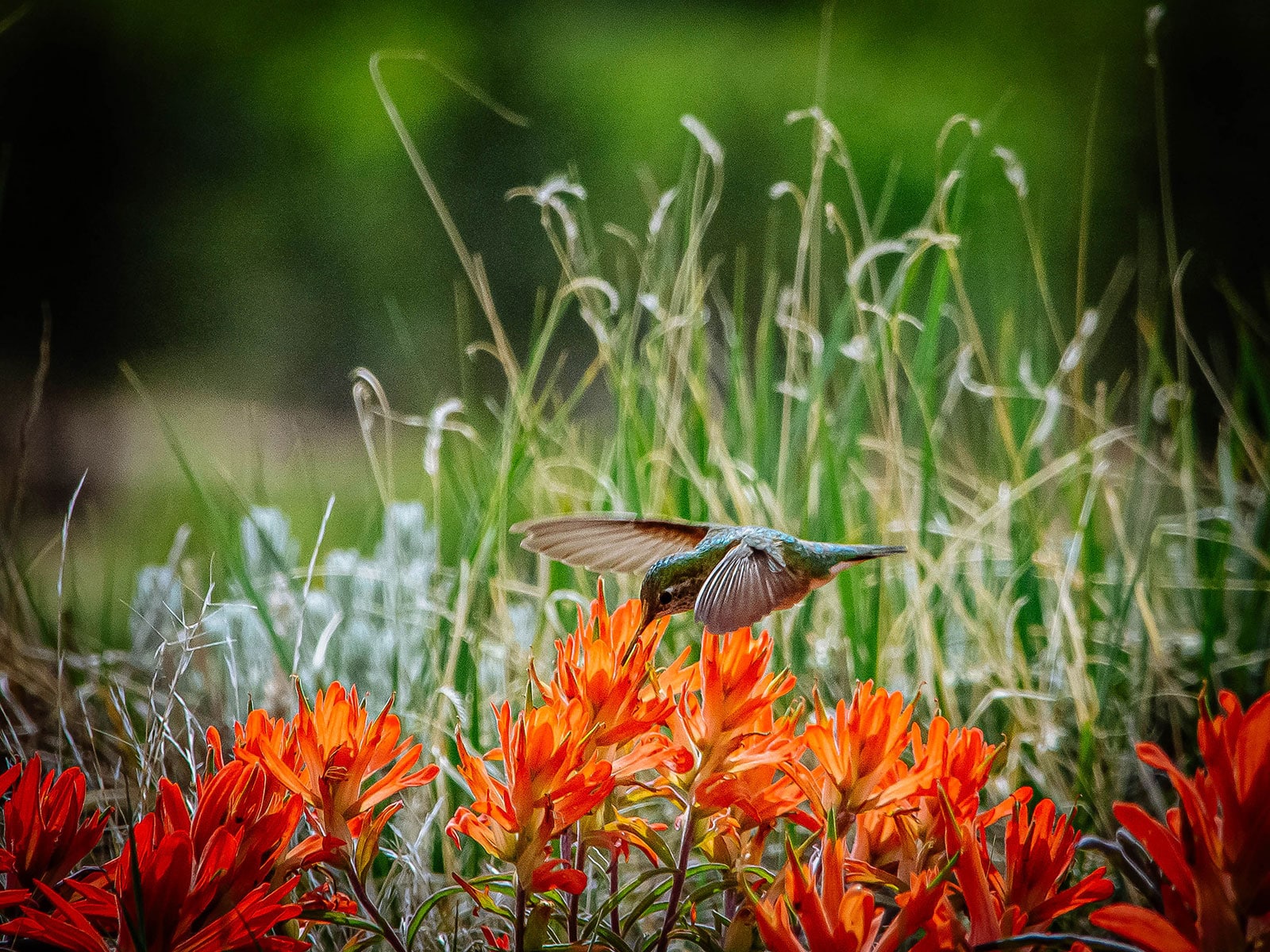
Plants of the genus Castilleja, better known as the Indian paintbrushes, are hummingbird magnets. They evolved to be pollinated specifically by our feathered friends, attracting them with their bright flowers and plentiful nectar production.
Hummingbirds will go for most Castilleja species, but one stands out: C. coccinea, the scarlet Indian paintbrush. This plant is primarily pollinated by one of the most common US hummers, the exquisite ruby-throated hummingbird.
Ruby-throats are pretty much the only species to visit the eastern USA, so if you live on this side of the country, the scarlet Indian paintbrush is a must for your hummingbird garden. A typical wildflower, this plant likes full sun, well-draining soil, and regular watering.
USDA Zones: 4 to 9
4. Larkspur (genus Delphinium)
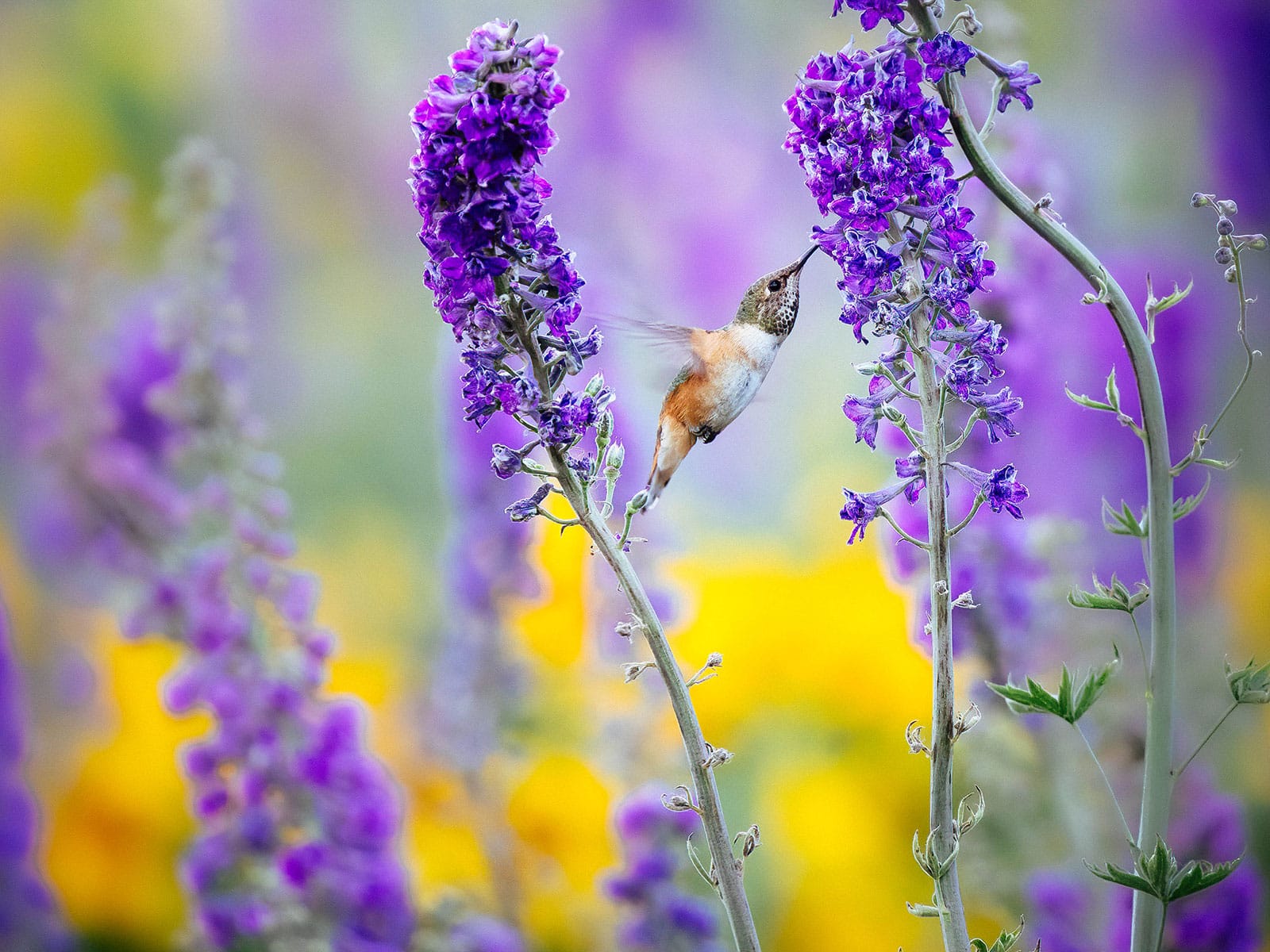
Oh, how lovely are larkspurs! It’s hard not to adore the tall, flower-studded spikes in all shades of blue, purple, pink, peach, and white. And it seems we’re not alone in this: Hummingbirds really like these colorful members of the genus Delphinium too.
There are lots of different larkspur species to choose from. If you’re specifically looking for plants that attract hummingbirds, go for ones that don’t have overly dense flower spikes rather than the super-showy hybrids. Examples include Delphinium barbeyi (Rocky Mountain larkspur), D. cardinale (scarlet larkspur), D. nudicale (red larkspur), and D. nuttallianum.
Most larkspurs are annuals. You can sow in well-draining soil in a sunny spot in fall or early spring to enjoy their beautiful flowers in spring or early summer. Water regularly and consider applying some fertilizer every few weeks to encourage abundant blooming.
USDA Zones: 2 to 11
Quick Tip
The common name “larkspur” is also used for a different genus, Consolida. The good news is that they’re similar, and Consolidas are also likely to attract hummingbirds. So no worries if you mix them up!
5. Honeysuckle (genus Lonicera)
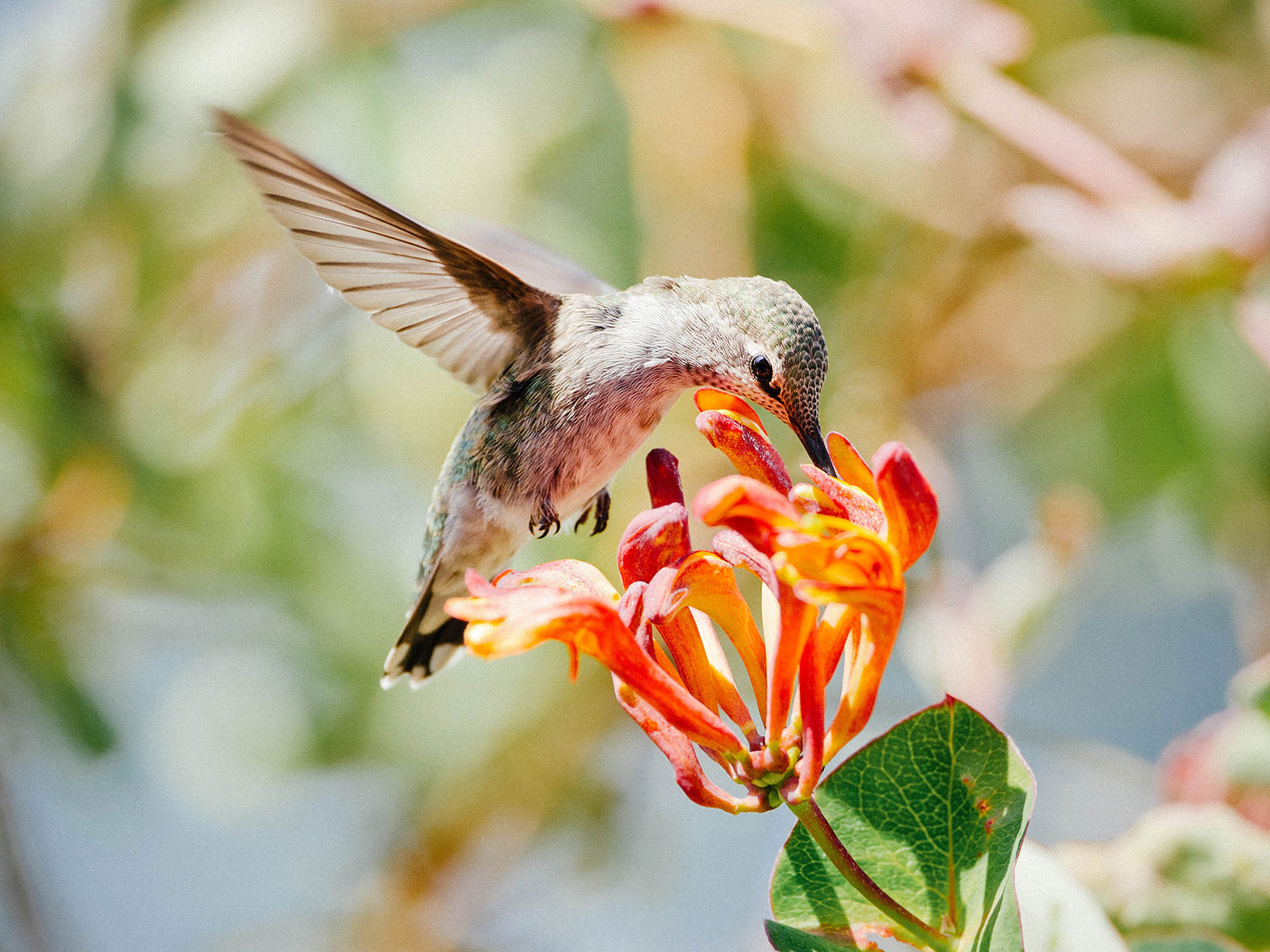
Another one of those plants that’s equally beloved by both humans and hummingbirds is honeysuckle. Some of the species in this genus, called Lonicera, evolved to be pollinated by hummingbirds, and it shows.
Let’s take Lonicera sempervirens, or coral honeysuckle, as an example. Remember our list of hummingbird-attracting flower attributes? Well, this one literally ticks all the boxes!
It has tubular flowers which are red in color and grow in clusters that are not overly tight. The blooms are rich in nectar, open during the day, and don’t emit a strong scent. Hummingbird heaven.
Although coral honeysuckle can be considered the superior choice, there are a few other species that would work well. Orange honeysuckle (L. ciliosa) is another nice option that’s native to the US.
Honeysuckle is not too hard to grow. It likes plenty of sun and well-draining soil, and it doesn’t require much water to thrive. You do need to provide some support for the vining varieties, such as coral honeysuckle.
USDA Zones: 4 to 10
6. Beardtongues (genus Penstemon)
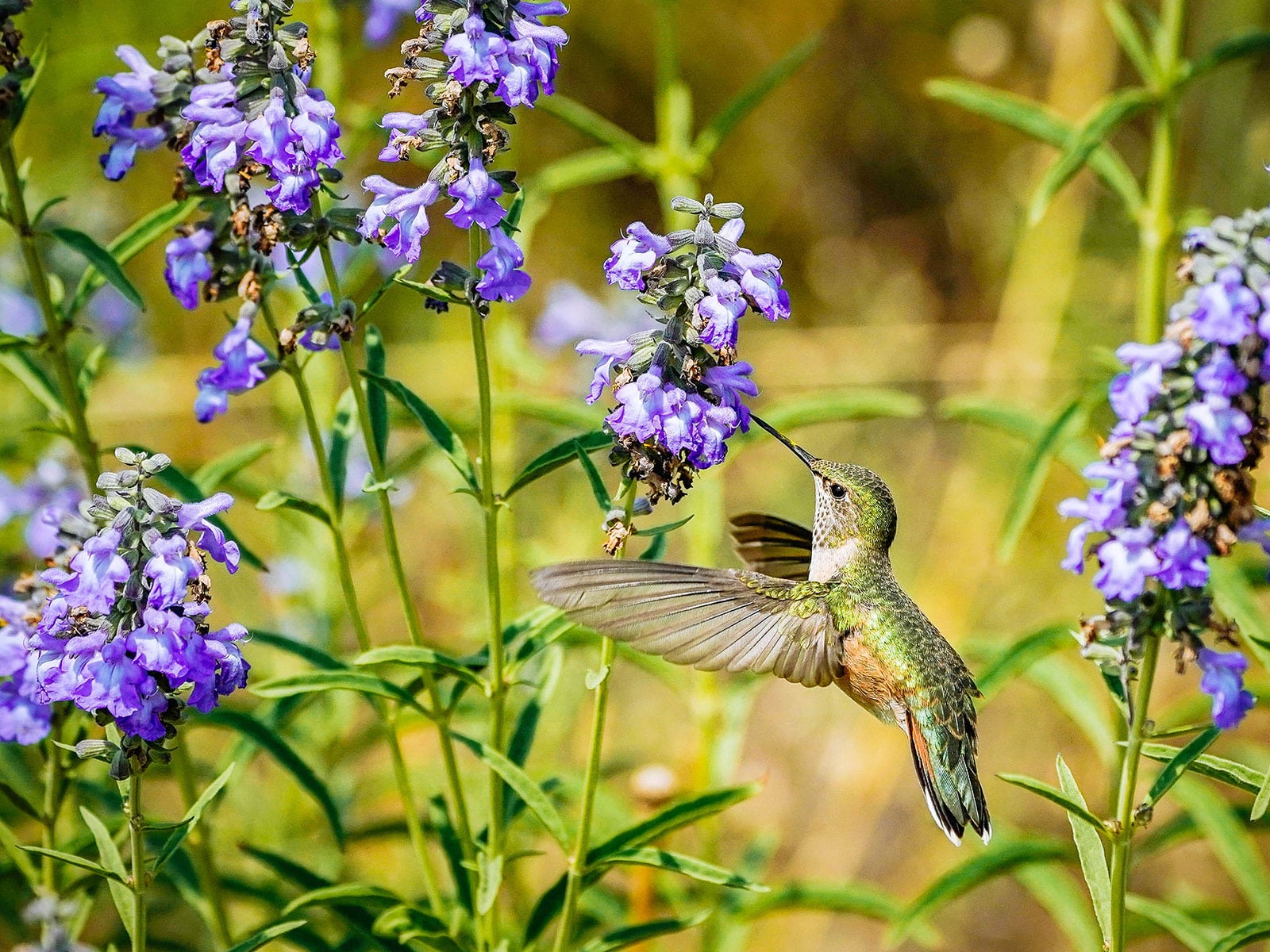
Somewhat similar in looks to larkspurs, Penstemon (the beardtongues) is a genus of native wildflowers that’s popular among gardeners thanks to its abundant, colorful blooms. And it’s popular among hummingbirds, too!
Although most beardtongue species (such as P. strictus, the Rocky Mountain penstemon) evolved to be pollinated by bees, scientists have found that about 30 species are perfect for hummingbirds.
My number-one choice is P. barbatus, the dazzlingly red beardlip penstemon, but P. cardinalis (cardinal beardtongue) and P. eatonii (firecracker penstemon) are also highly suitable.
Beardtongues are not fussy, although they are very sensitive to poorly drained soil. Grow yours in a sandy or gravelly, well-draining medium; refrain from watering in winter; and don’t be too heavy-handed with your watering can in summer either. With the right care, beardtongues will bloom from late spring to early fall!
USDA Zones: 3 to 9
7. Currants (genus Ribes)
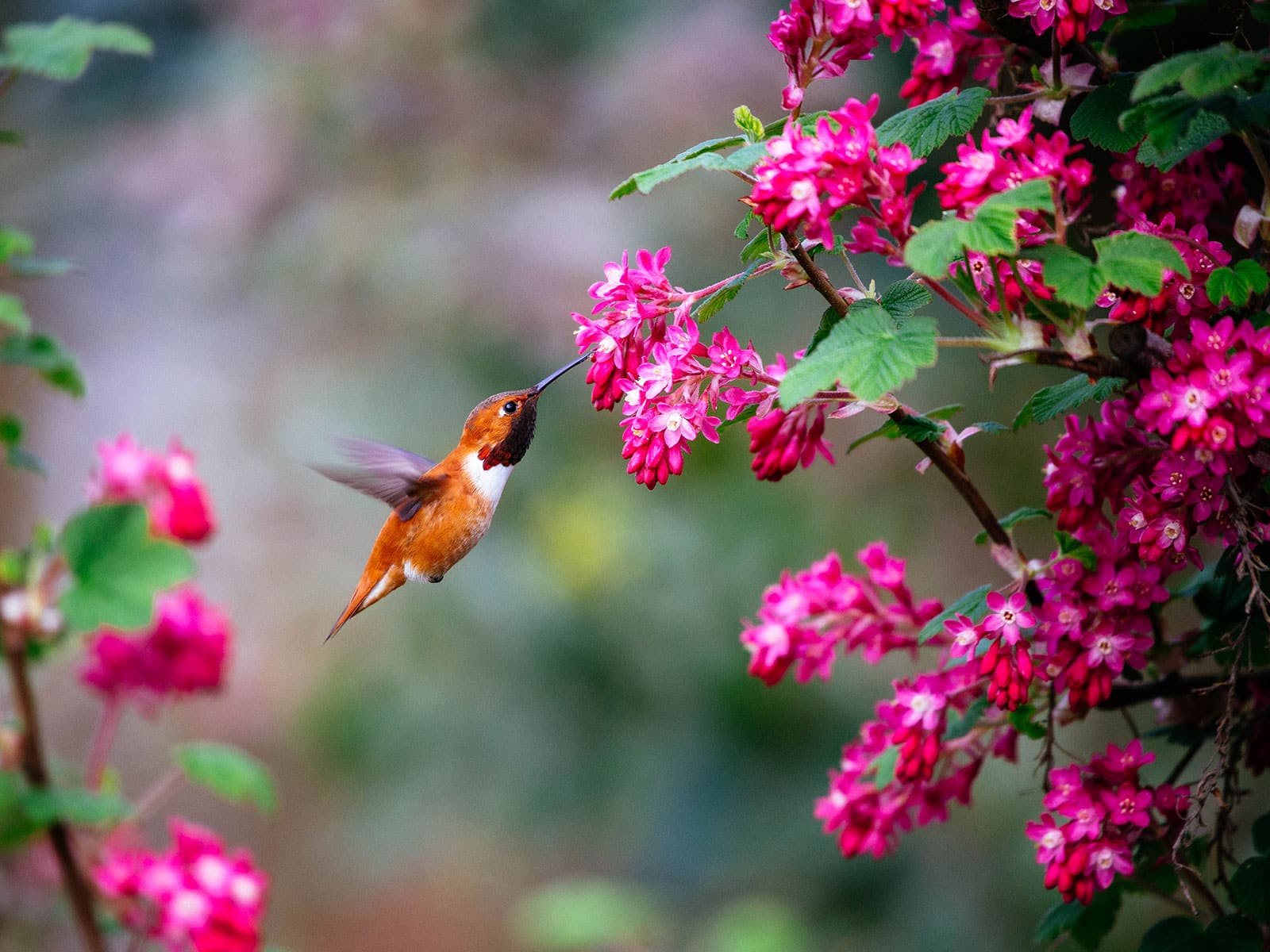
Gotta love a plant that attracts hummingbirds and produces tasty fruits for us humans to eat. We already discussed the prickly pear cactus, but what if you don’t live in an arid climate?
Well, here’s a stellar option: Hummingbirds love the flowers produced by currant and gooseberry bushes of the genus Ribes.
Like many of the other plants on this list, certain currant species evolved specifically for hummingbirds (this is called pollination mutualism, by the way, implying that both plant and bird benefit). One example of these Ribes + hummingbird best friends is Anna’s hummingbird + Ribes speciosum, the fuchsiaflower gooseberry.
Other excellent choices include the lovely flowering currant (R. sanguineum) and golden currant (R. aureum). All of these grow in a bushy fashion and like full sun to partial shade. Yours will prefer moist but well-draining soil and a yearly prune after the fruiting season.
USDA Zones: 4 to 8 (highly variable)
8. Sages (genus Salvia)
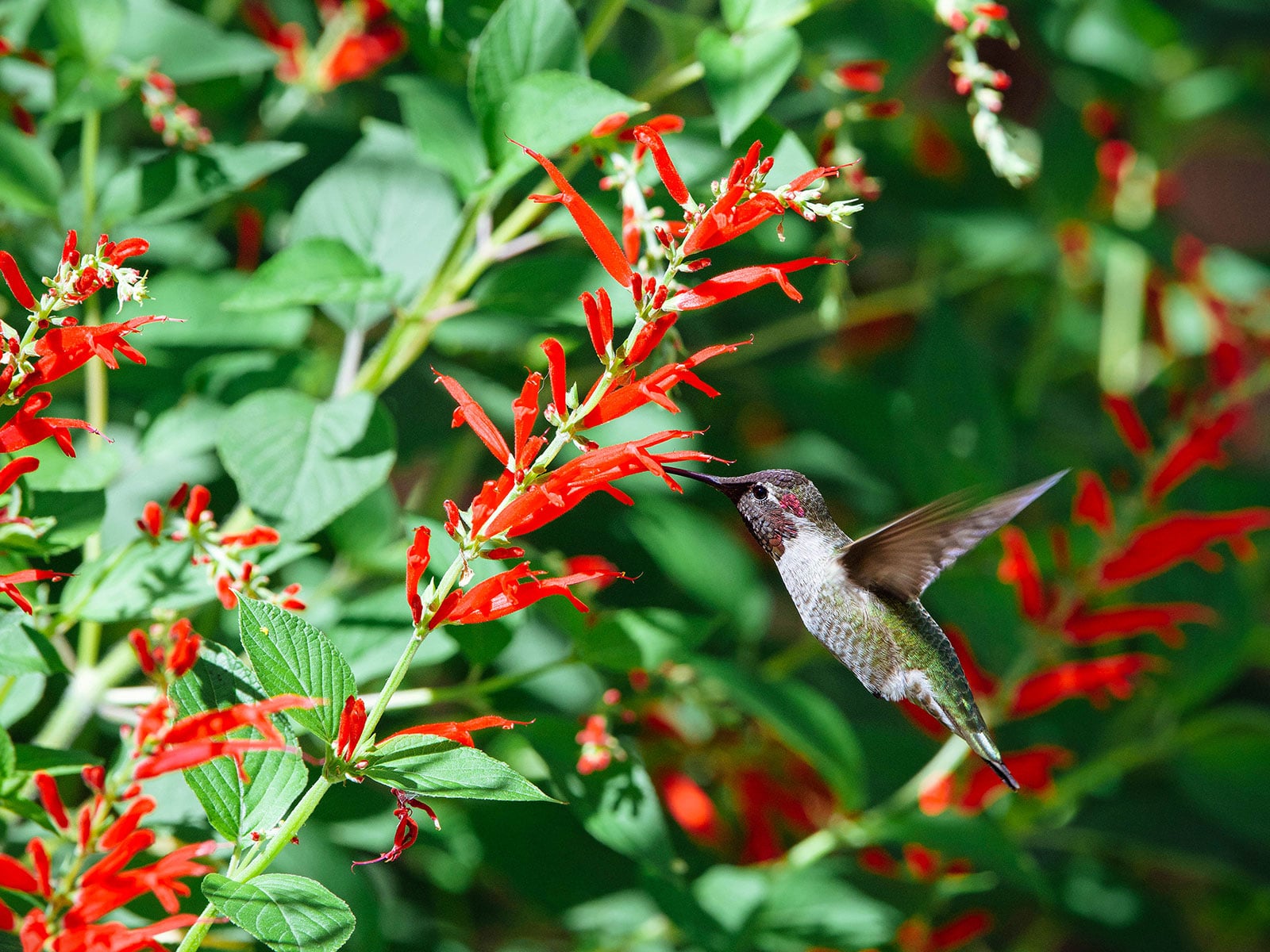
If you know a little about the best plants for pollinators, you’ll be aware you can’t go wrong with those in the mint family Lamiaceae. And yep, hummingbirds are no exception. They go crazy for some of these herbs, particularly the sages of the genus Salvia.
Now, most of us are familiar with common sage (Salvia officinalis), but this one’s from the Mediterranean and not adapted to attract hummingbirds.
Luckily, there are almost 1,000 species in total, so there’s plenty more to choose from. Scientists have found that 31 percent of the Salvia species found in the Americas are bird-pollinated!
You can draw hummingbirds to your yard with common red-blooming sages like hummingbird sage (S. guaranitica, and yes, that really is its common name), pineapple sage (S. elegans, one of my personal favorites and the type featured in the image above), Cleveland sage (S. clevelandii), and more.
Sages are pretty forgiving, so you shouldn’t have trouble growing them. They like plenty of sun, well-draining soil, a good drink when dry, and a bit of fertilizer during the growing season. Most bloom between late spring through summer.
USDA Zones: 5 to 10 (highly variable)
9. Fuchsias (genus Fuchsia)
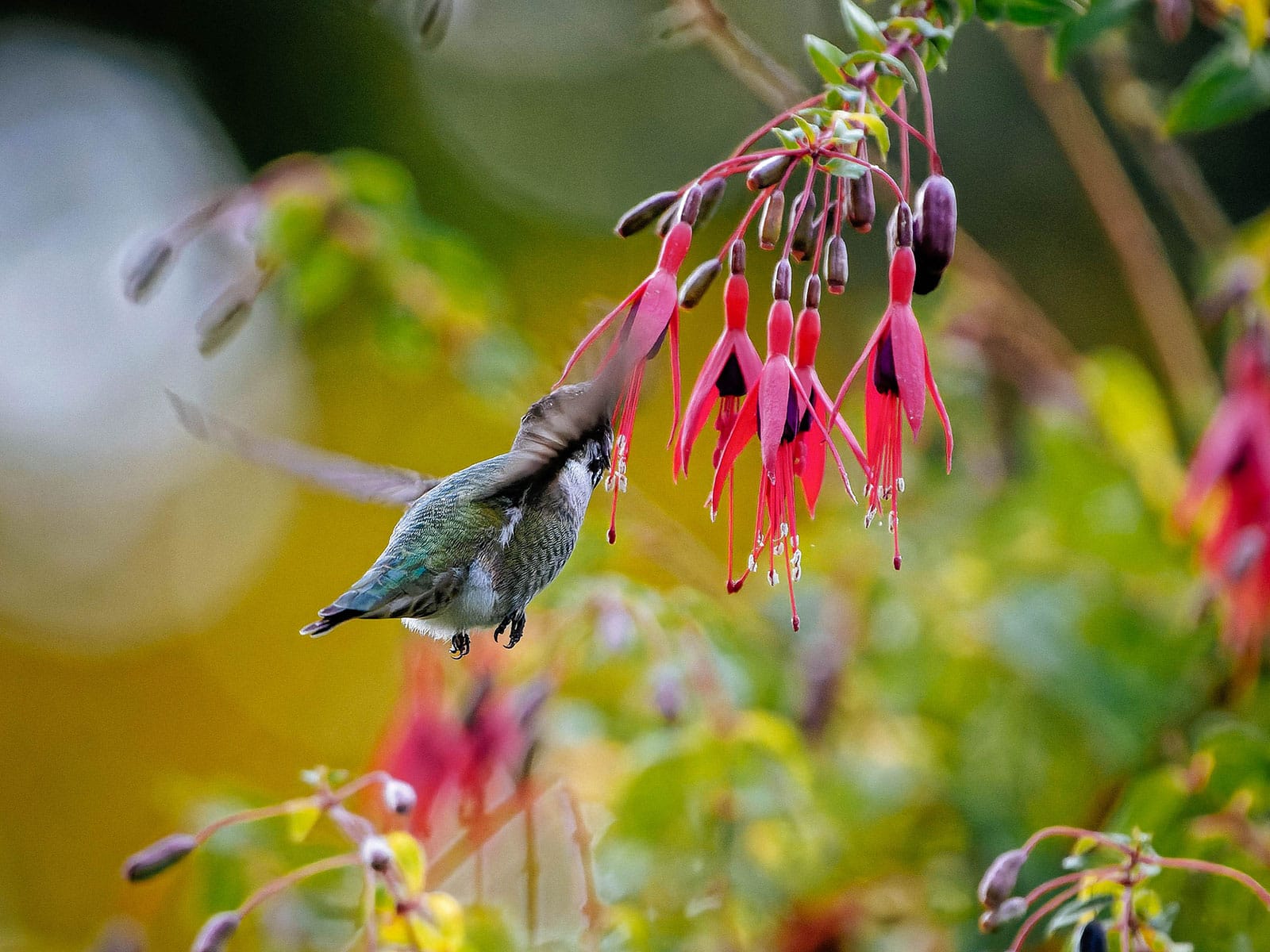
I don’t think any of my readers will be sad to hear that fuchsias are a must in any hummingbird-oriented garden! This classic summer bloomer is a long-time favorite thanks to its elegant, teardrop-shaped flowers and truly eye-popping colors.
One fuchsia in particular to look out for is F. magellanica. This species’ deep reddish-pink outer flower petals and abundant nectar production make it such a hit with our fluttering friends that it’s actually commonly known as “hummingbird fuchsia”—need I say more?
This South American fuchsia isn’t just irresistible to hummingbirds and amazing to look at, but it’s also easy to grow. Because it’s from the lower part of the continent, it’s hardier than many other fuchsias, and it doesn’t require much attention. In fact, one of its nicknames is “hardy fuchsia.”
You can plant your fuchsias in rich and lightly moist soil, preferably in partial shade. A happy specimen will flower from May to October in most climates.
USDA Zones: 6 and up
10. Bee balm (genus Monarda)
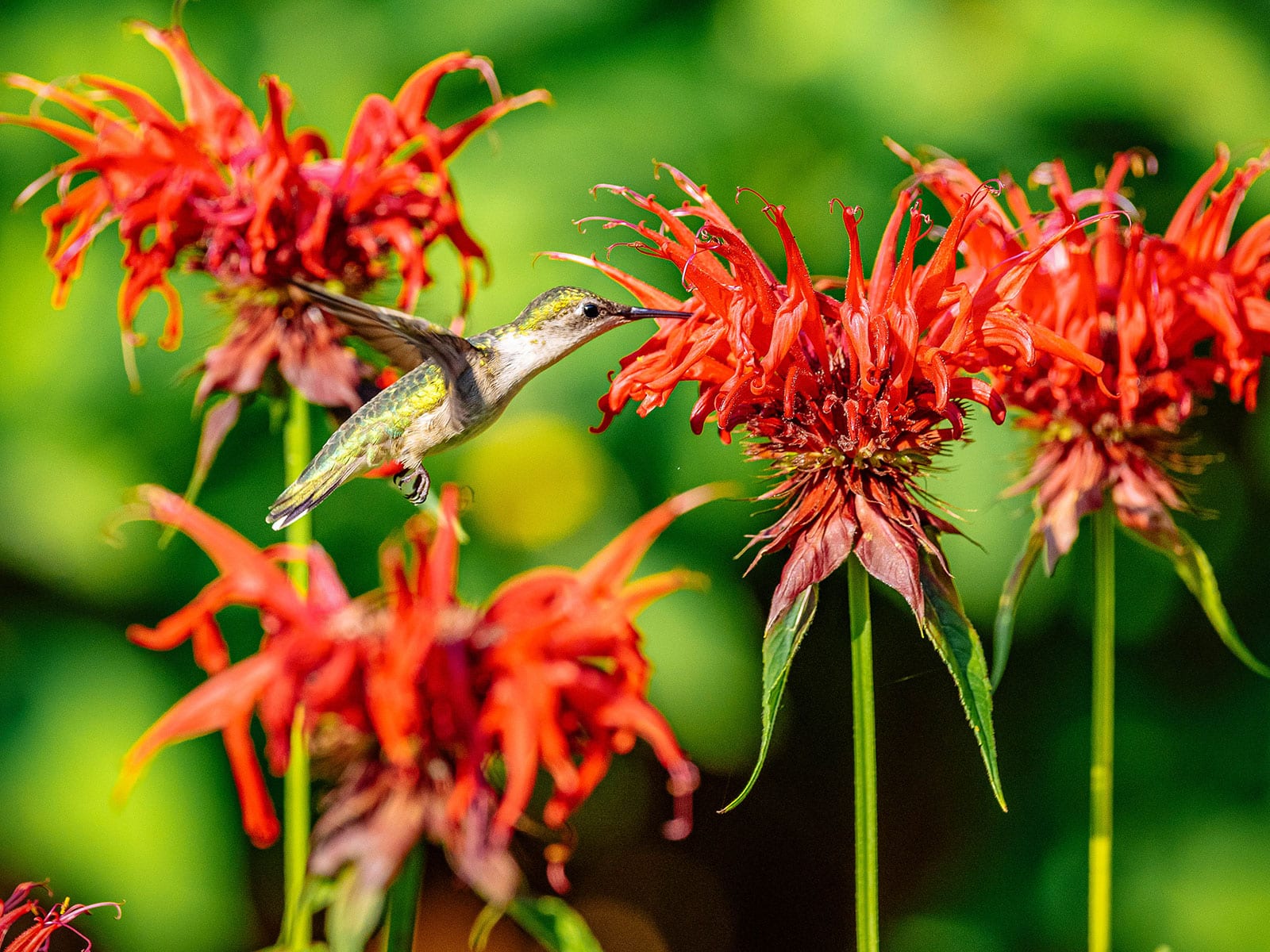
When it comes to flowers beloved by pollinators, bee balm (another member of the mint family) is very hard to beat. It got its name for a reason, as bees do adore it. But they’ve got some stiff competition! Butterflies and moths are also big fans, as are hummingbirds. I grow a few cultivars in my own garden for another reason: it’s an edible flower with delicious, citrusy petals.
There are around 20 bee balm species. The one most likely to please your local hummingbird population also happens to be the one that’s easiest to find at your local garden center: Monarda didyma, better known as scarlet bee balm.
Although bee balm is notorious for its sensitivity to powdery mildew, things don’t have to end like that for yours. Just be sure it gets plenty of sun and ensure the soil stays evenly moist but never soggy. Good airflow is crucial!
USDA Zones: 3 to 9
11. Lobelias
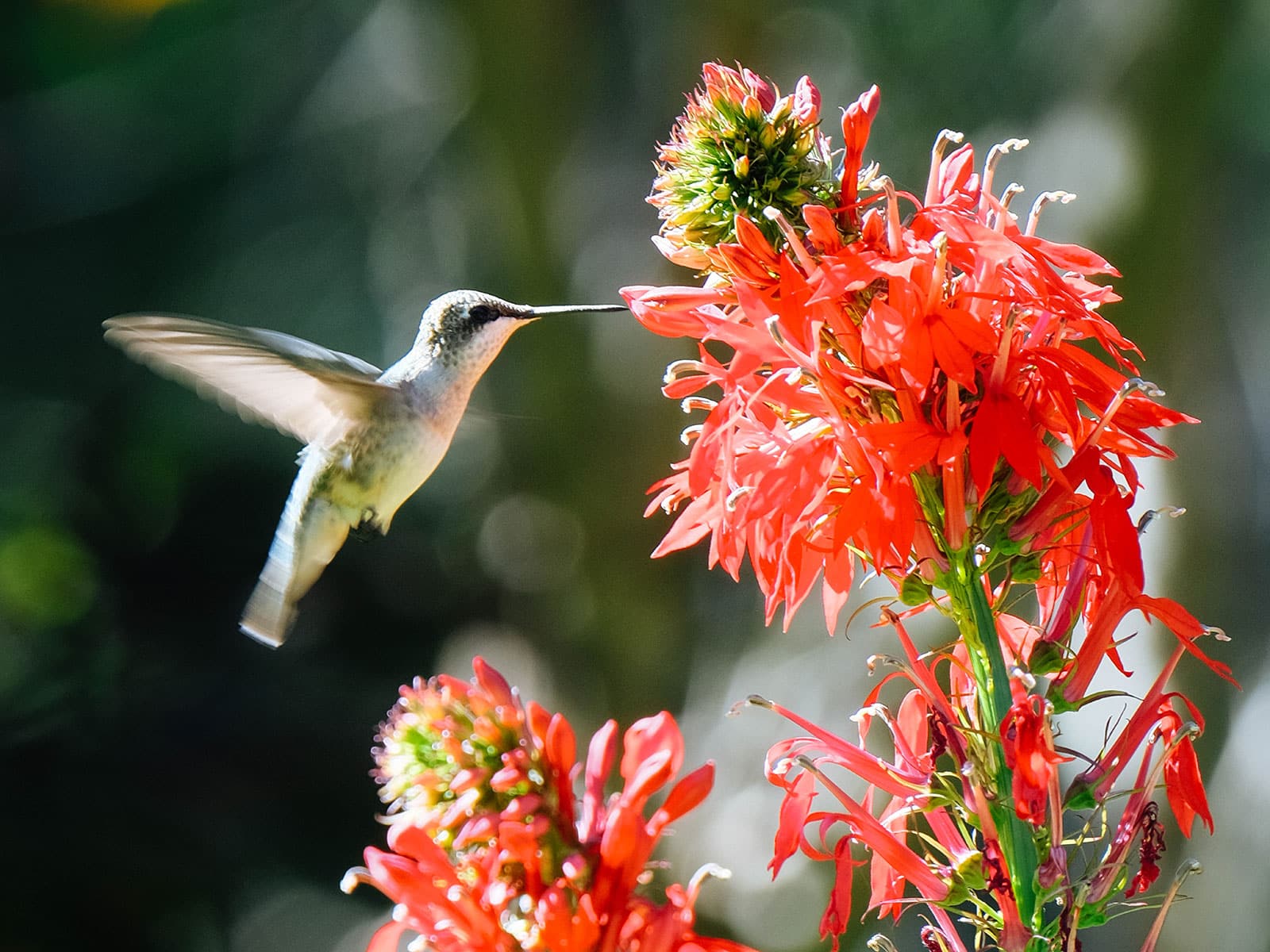
The genus Lobelia consists of 415 species spread throughout much of the globe. Most of its members are pollinated by bees, but a few that are naturally found in the Americas have evolved specifically to attract hummingbirds.
By far my favorite option is the cardinal flower, L. cardinalis. Being native to the majority of the US (except the northwest), this species is particularly well-adapted to our North American climate, meaning it should be easy to grow in most areas.
Like some of the other plants on our list, it has developed a special relationship with a specific species of hummingbird: ruby-throated hummingbirds are pretty much its only pollinator.
Another hummer favorite is the Mexican Lobelia (L. laxiflora), but as its name suggests, that one does best in warm and dry climates.
You can grow your Lobelias in full sun to partial shade. All you have to do is keep the soil moist—they really don’t like drought. You can expect an abundance of red flowers (plus accompanying hummingbirds) in late summer.
USDA Zones: 3 to 9
12. Petunias

You may already have these in your garden—Petunias are a staple for those among us who enjoy growing flowers. But did you know that hummingbirds like them as well?
Most Petunia species have evolved to be pollinated by insects. The exception is the bright red and relatively rare Petunia exserta, which is native to Brazil and pollinated by hummingbirds in the wild. As I’ve mentioned, though, hummers aren’t as picky about their food as plants are about their pollinators. They’ll go for many Petunia species!
If you’d like to attract hummingbirds, try going for red Petunias, their favorite color. These tender perennials like plenty of sun, well-draining soil, and regular waterings. They can bloom from spring all the way to the first frost of the year, ensuring your local hummingbirds have a source of food even in late fall.
USDA Zones: 9 to 11 (otherwise annual)
13. Zinnias
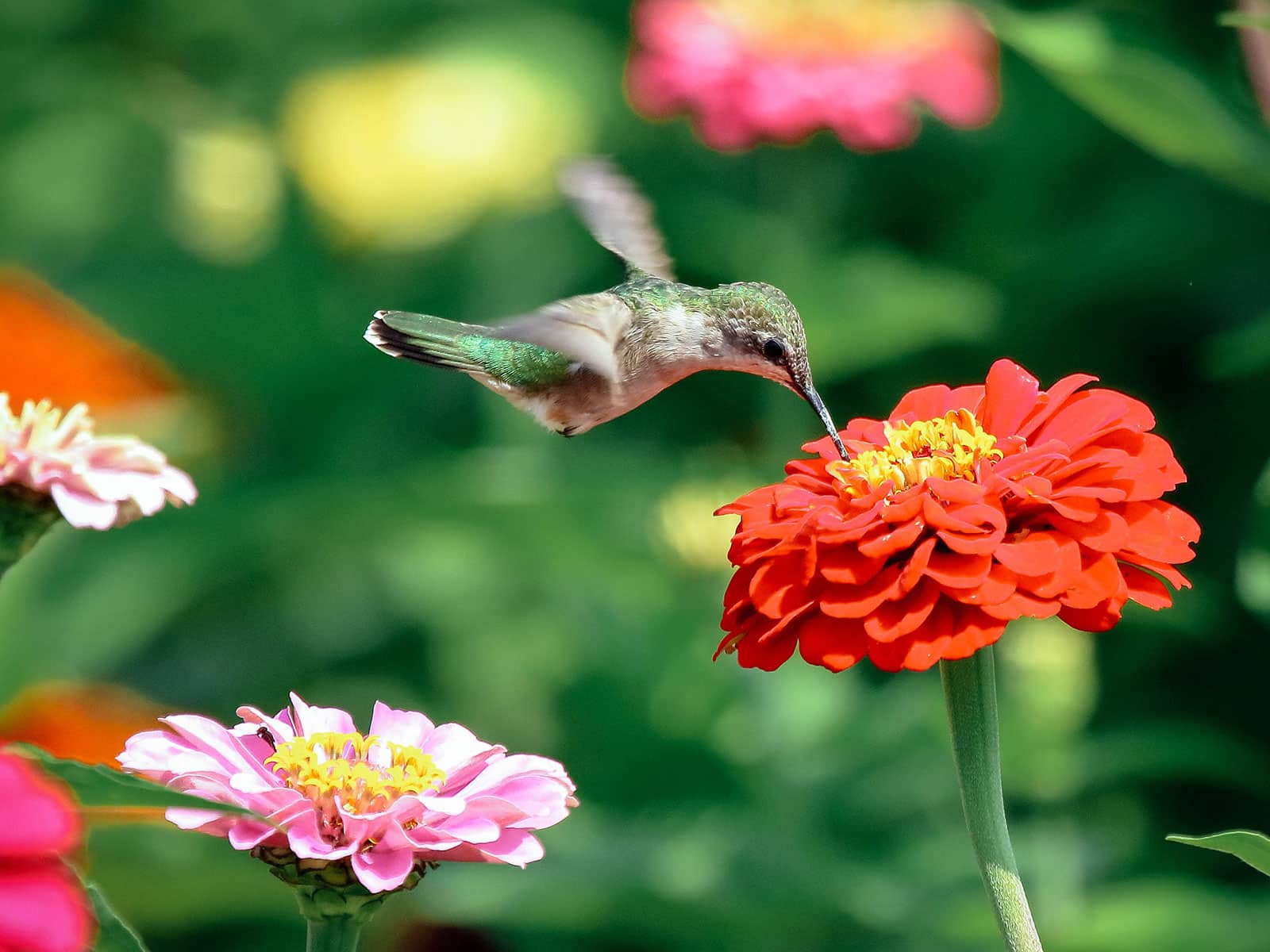
Zinnias are another example of plants that technically haven’t evolved to be pollinated by hummingbirds, but that have still proven to be wildly attractive to them. Members of the sunflower family, they lack the typical tubular shape of hummingbird flowers. But because they produce a lot of nectar, it’s hard for the birds to resist!
I definitely recommend including a few Zinnias in your hummingbird garden. As always, try going for red cultivars for the best chances of success, and avoid the fancy multi-petaled varieties—they make it harder for your fluttery visitors to reach the nectar.
You can sow these annuals once the risk of frost has passed. They like well-draining soil and are sensitive to rot, though they do need regular watering for the best results. The cheerful flowers last from late spring to the first frost
USDA Zones: 2 to 11
14. Trumpet vine (Campsis radicans)

Look at the flowers on this one! Could there be anything more perfect for hummingbirds? And indeed, the North American trumpet (Campsis radicans) is a typical example of a hummingbird-pollinated flower. Its best friend is the ruby-throated hummingbird.
Also appropriately known as the hummingbird vine, this plant is one of only two in its genus (the other one is naturally found in East Asia and is pollinated by bees and wasps). It makes the perfect choice if you’re looking for a native vining plant to attract hummers to your garden, and the lovely trumpet-shaped flowers don’t hurt either.
Native to the southeastern US, the trumpet vine likes plenty of sun. It will do well in a wide range of soil types and appreciates regular waterings. Do keep in mind that this is a very vigorous grower; you have to be willing to perform regular maintenance to prevent it from getting out of control.
USDA Zones: 4 to 9
15. Firecracker plants (genus Russelia)
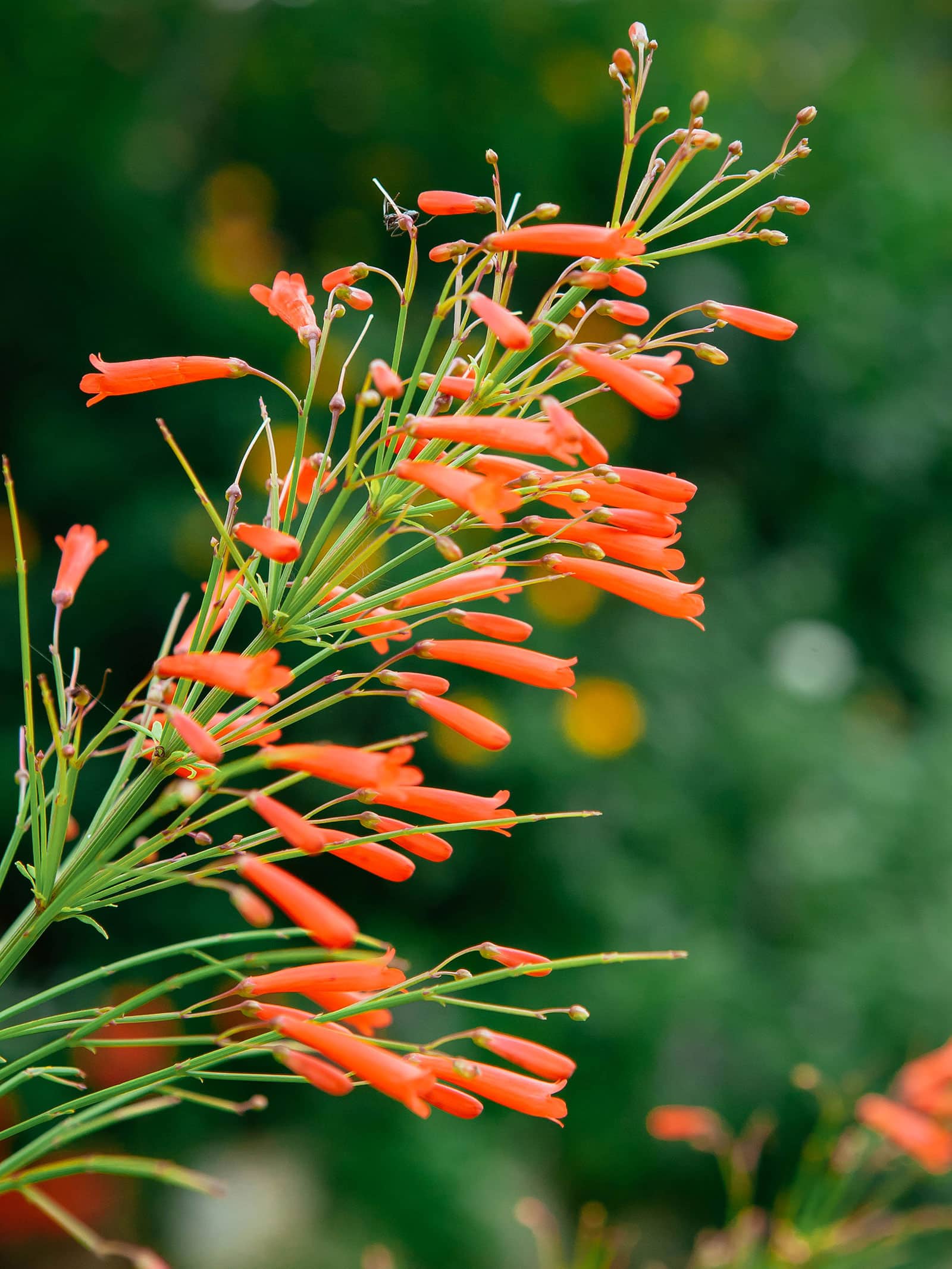
Looking for a beautiful cascading plant for a hanging planter or to use as a sprawling ground cover? Consider firecracker plants of the genus Russelia, which aren’t just beautiful to look at but also attract hummingbirds and other pollinators with their tubular red flowers.
Related: Plant these evergreen ground covers for year-round interest in the garden
The most popular firecracker plant is Russelia equisetiformis, also known as the fountainbush. This one’s a favorite among hummingbirds, though you should try to avoid the non-red cultivars (it also comes in white and cream) for the best results.
Firecracker plants are native to Central America and Mexico, making them suitable for warmer climates. They’re pretty sturdy and tolerant of abuse, growing well in a range of soil types. Medium moisture is ideal, but established plants don’t mind short droughts either. They bloom throughout spring and summer.
USDA Zones: 9 to 11
16. Butterfly bushes (genus Buddleja)

The ubiquitous butterfly bush (Buddleja davidii), a fixture in butterfly gardens and long-time favorite for attracting other pollinators to our gardens, has come under fire in recent years as a result of its invasive nature. Native to China and Japan, it can escape from gardens and negatively affect local ecosystems.
So what should you do? After all, this gorgeous plant (sometimes also referred to as summer lilac) is perfect for attracting all kinds of butterflies and hummingbirds to your garden. There is a solution: sterile cultivars that can’t produce new plants from seed. If you want to grow a butterfly bush, varieties like ‘Flutterby’ and ‘Blue Chip’ are safe options.
You could also consider going for Buddleja species that are native to the Americas. Although these are more difficult to find, many have evolved to be hummingbird-pollinated, making them very effective at attracting hummers to your yard. Buddleja tubiflora is a good example.
Most types of butterfly bushes grow in a shrubby fashion and are easy to maintain. They appreciate a sunny spot in your garden and do best in moist but well-draining soil. You can expect flowers throughout summer.
USDA Zones: 5 to 10 (or 9 to 10 for B. tubiflora)
17. Foxgloves (genus Digitalis)
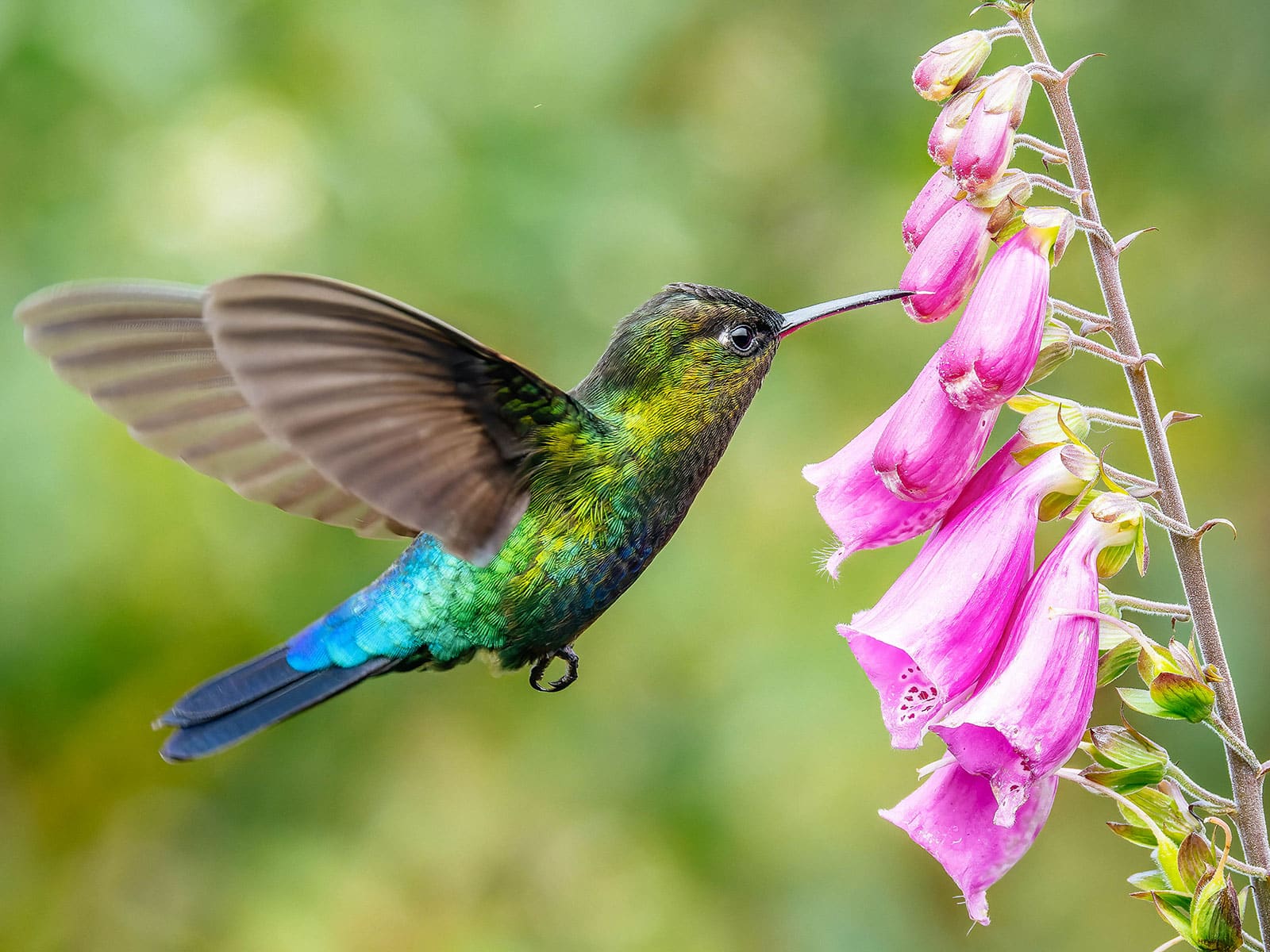
Although they’re not native to the Americas like hummingbirds, and therefore not technically hummingbird-pollinated, our feathered friends will still flock to the nectar produced by foxglove flowers of the genus Digitalis. Scientists call this “nectar robbing,” as the plant loses its nectar but doesn’t benefit from pollination in return.
Does this matter to us gardeners? Nope! Plant some foxgloves, such as the popular Digitalis purpurea, and let the hummingbirds rob as much as they want. Whether the flowers are pollinated or not is irrelevant to us, as most people don’t mind buying seeds for this biennial plant.
Foxgloves need two years to develop and will bloom in the second year. Sow them in rich and moist but well-draining soil. Although some species like full sun, most do best in half shade.
USDA Zones: 4 to 9
Sources:
- Abrahamczyk, S., Poretschkin, C., & Renner, S. S. (2017). Evolutionary flexibility in five hummingbird/plant mutualistic systems: testing temporal and geographic matching. Journal of Biogeography, 44(8), 1847-1855.
- Abrahamczyk, S., & Renner, S. S. (2015). The temporal build-up of hummingbird/plant mutualisms in North America and temperate South America. BMC evolutionary biology, 15, 1-12.
- Abrahamczyk, S., Weigend, M., Becker, K., Dannenberg, L. S., Eberz, J., Atella‐Hödtke, N., & Steudel, B. (2022). Influence of plant reproductive systems on the evolution of hummingbird pollination. Ecology and Evolution, 12(2), e8621.
- Aguilar-Rodríguez, P. A., MacSwiney G, M. C., Krömer, T., García-Franco, J. G., Knauer, A., & Kessler, M. (2014). First record of bat-pollination in the species-rich genus Tillandsia (Bromeliaceae). Annals of botany, 113(6), 1047-1055.
- Armstrong, D. P. (1987). Economics of breeding territoriality in male Calliope Hummingbirds. The Auk, 104(2), 242-253.
- Benitez-Vieyra, S., Fornoni, J., Pérez-Alquicira, J., Boege, K., & Dominguez, C. A. (2014). The evolution of signal–reward correlations in bee-and hummingbird-pollinated species of Salvia. Proceedings of the Royal Society B: Biological Sciences, 281(1782), 20132934.
- Berardi, A. E., Esfeld, K., Jäggi, L., Mandel, T., Cannarozzi, G. M., & Kuhlemeier, C. (2021). Complex evolution of novel red floral color in Petunia. The plant cell, 33(7), 2273-2295.
- Caruso, C. M., Peterson, S. B., & Ridley, C. E. (2003). Natural selection on floral traits of Lobelia (Lobeliaceae): spatial and temporal variation. American Journal of Botany, 90(9), 1333-1340.
- Castellanos, M. C., Wilson, P., & Thomson, J. D. (2004). ‘Anti‐bee’and ‘pro‐bird’changes during the evolution of hummingbird pollination in Penstemon flowers. Journal of evolutionary biology, 17(4), 876-885.
- Elias, T. S., & Gelband, H. (1975). Nectar: its production and functions in trumpet creeper. Science, 189(4199), 289-291.
- Hayden, W. J. (2014). Humming Birds: Pollination Facts and Fancy. Bulletin of the Virginia Native Plant Society, 33(2), 1.
- Hoyo, J. D., Elliott, A., & Sargatal, J. (1992). Handbook of the Birds of the World Vol. 1. Lynx Edicions/Birdlife International.
- Ippolito, A., Fernandes, G. W., & Holtsford, T. P. (2004). Pollinator preferences for Nicotiana alata, N. forgetiana, and their F1 hybrids. Evolution, 58(12), 2634-2644.
- Kessler, D., Bhattacharya, S., Diezel, C., Rothe, E., Gase, K., Schöttner, M., & Baldwin, I. T. (2012). Unpredictability of nectar nicotine promotes outcrossing by hummingbirds in Nicotiana attenuata. The Plant Journal, 71(4), 529-538.
- Mackin, C. R., Goulson, D., & Castellanos, M. C. (2021). Novel nectar robbing negatively affects reproduction in Digitalis purpurea. Ecology and Evolution, 11(19), 13455-13463.
- Silva, F. A., Chatt, E. C., Mahalim, S. N., Guirgis, A., Guo, X., Nettleton, D. S., … & Thornburg, R. W. (2020). Metabolomic profiling of Nicotiana Spp. nectars indicate that pollinator feeding preference is a stronger determinant than plant phylogenetics in shaping nectar diversity. Metabolites, 10(5), 214.
- Wessinger, C. A., Rausher, M. D., & Hileman, L. C. (2019). Adaptation to hummingbird pollination is associated with reduced diversification in Penstemon. Evolution letters, 3(5), 521-533.
- Williams, C. F., Ruvinsky, J., Scott, P. E., & Hews, D. K. (2001). Pollination, breeding system, and genetic structure in two sympatric Delphinium (Ranunculaceae) species. American Journal of Botany, 88(9), 1623-1633.


